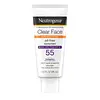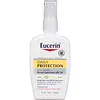What's inside
What's inside
 Key Ingredients
Key Ingredients

 Benefits
Benefits

 Concerns
Concerns

 Ingredients Side-by-side
Ingredients Side-by-side

Butyl Methoxydibenzoylmethane 2.7%
UV AbsorberHomosalate 4%
Skin ConditioningEthylhexyl Salicylate 4.5%
UV AbsorberOctocrylene 6%
UV AbsorberBenzophenone-3 4.5%
UV AbsorberWater
Skin ConditioningSilica
AbrasiveCetyl Dimethicone
EmollientStyrene/Acrylates Copolymer
C12-15 Alkyl Benzoate
AntimicrobialSteareth-100
Gel FormingEthylhexylglycerin
Skin ConditioningPhenoxyethanol
PreservativeCaprylyl Glycol
EmollientSodium Polyacrylate
AbsorbentDimethicone
EmollientSteareth-2
EmulsifyingPolyester-7
Skin ConditioningChlorphenesin
AntimicrobialPropylene Glycol
HumectantEthylhexyl Stearate
EmollientNeopentyl Glycol Diheptanoate
EmollientBisabolol
MaskingDisodium EDTA
Butylene Glycol
HumectantAcrylates/Dimethicone Copolymer
Skin ConditioningDiethylhexyl 2,6-Naphthalate
EmollientMannan
Xanthan Gum
EmulsifyingBHT
AntioxidantCapryloyl Glycine
CleansingTrideceth-6
EmulsifyingSarcosine
Skin ConditioningCedrus Atlantica Bark Extract
PerfumingCinnamomum Zeylanicum Bark Extract
AntimicrobialPortulaca Oleracea Extract
Skin ConditioningButyl Methoxydibenzoylmethane 2.7%, Homosalate 4%, Ethylhexyl Salicylate 4.5%, Octocrylene 6%, Benzophenone-3 4.5%, Water, Silica, Cetyl Dimethicone, Styrene/Acrylates Copolymer, C12-15 Alkyl Benzoate, Steareth-100, Ethylhexylglycerin, Phenoxyethanol, Caprylyl Glycol, Sodium Polyacrylate, Dimethicone, Steareth-2, Polyester-7, Chlorphenesin, Propylene Glycol, Ethylhexyl Stearate, Neopentyl Glycol Diheptanoate, Bisabolol, Disodium EDTA, Butylene Glycol, Acrylates/Dimethicone Copolymer, Diethylhexyl 2,6-Naphthalate, Mannan, Xanthan Gum, BHT, Capryloyl Glycine, Trideceth-6, Sarcosine, Cedrus Atlantica Bark Extract, Cinnamomum Zeylanicum Bark Extract, Portulaca Oleracea Extract
Phenylbenzimidazole Sulfonic Acid 2%
UV AbsorberEthylhexyl Methoxycinnamate 7.5%
UV AbsorberEthylhexyl Salicylate 4.5%
UV AbsorberTitanium Dioxide 2.4%
Cosmetic ColorantZinc Oxide 4.8%
Cosmetic ColorantWater
Skin ConditioningGlycerin
HumectantC12-15 Alkyl Benzoate
AntimicrobialDimethicone
EmollientCyclomethicone
EmollientMethylpropanediol
SolventCetearyl Alcohol
EmollientCetyl Alcohol
EmollientCeteareth-20
CleansingPhenoxyethanol
PreservativeGlyceryl Stearate Se
EmulsifyingSodium Lactate
BufferingLactic Acid
Buffering1,2-Hexanediol
Skin ConditioningHydrogenated Coco-Glycerides
EmollientVp/Hexadecene Copolymer
Xanthan Gum
EmulsifyingPEG-40
HumectantRicinus Communis Seed Oil
MaskingSodium Hydroxide
BufferingTrisodium EDTA
Alumina
AbrasiveSodium Cetearyl Sulfate
CleansingTriethoxycaprylylsilane
Simethicone
EmollientPhenylbenzimidazole Sulfonic Acid 2%, Ethylhexyl Methoxycinnamate 7.5%, Ethylhexyl Salicylate 4.5%, Titanium Dioxide 2.4%, Zinc Oxide 4.8%, Water, Glycerin, C12-15 Alkyl Benzoate, Dimethicone, Cyclomethicone, Methylpropanediol, Cetearyl Alcohol, Cetyl Alcohol, Ceteareth-20, Phenoxyethanol, Glyceryl Stearate Se, Sodium Lactate, Lactic Acid, 1,2-Hexanediol, Hydrogenated Coco-Glycerides, Vp/Hexadecene Copolymer, Xanthan Gum, PEG-40, Ricinus Communis Seed Oil, Sodium Hydroxide, Trisodium EDTA, Alumina, Sodium Cetearyl Sulfate, Triethoxycaprylylsilane, Simethicone
 Reviews
Reviews

Ingredients Explained
These ingredients are found in both products.
Ingredients higher up in an ingredient list are typically present in a larger amount.
C12-15 Alkyl Benzoate is made up of Benzoic Acid and long chain alcohols. It has a low molecular weight.
C12-15 Alkyl Benzoate is an emollient and texture enhancer. Due to its solubility, it is often used in sunscreens to help evenly distribute active ingredients.
As an emollient, C12-15 Alkyl Benzoate helps soften and hydrate your skin. Emollients create a film on your skin that traps moisture within.
This ingredient has been reported to cause eye irritation.
Learn more about C12-15 Alkyl BenzoateDimethicone is a type of synthetic silicone created from natural materials such as quartz.
What it does:
Dimethicone comes in different viscosities:
Depending on the viscosity, dimethicone has different properties.
Ingredients lists don't always show which type is used, so we recommend reaching out to the brand if you have questions about the viscosity.
This ingredient is unlikely to cause irritation because it does not get absorbed into skin. However, people with silicone allergies should be careful about using this ingredient.
Note: Dimethicone may contribute to pilling. This is because it is not oil or water soluble, so pilling may occur when layered with products. When mixed with heavy oils in a formula, the outcome is also quite greasy.
Learn more about DimethiconeEthylhexyl Salicylate is an organic compound used to block UV rays. It primarily absorbs UVB rays but offers a small amount of UVA protection as well.
Commonly found in sunscreens, Ethylhexyl Salicylate is created from salicylic acid and 2-ethylhexanol. You might know salicylic acid as the effective acne fighter ingredient and BHA.
The ethylhexanol in this ingredient is a fatty alcohol and helps hydrate your skin, similar to oils. It is an emollient, which means it traps moisture into the skin.
According to manufacturers, Ethylhexyl Salicylate absorbs UV wavelength of 295-315 nm, with a peak absorption at 307-310 nm. UVA rays are linked to long term skin damage, such as hyperpigmentation. UVB rays emit more energy and are capable of damaging our DNA. UVB rays cause sunburn.
Learn more about Ethylhexyl SalicylatePhenoxyethanol is a preservative that has germicide, antimicrobial, and aromatic properties. Studies show that phenoxyethanol can prevent microbial growth. By itself, it has a scent that is similar to that of a rose.
It's often used in formulations along with Caprylyl Glycol to preserve the shelf life of products.
Water. It's the most common cosmetic ingredient of all. You'll usually see it at the top of ingredient lists, meaning that it makes up the largest part of the product.
So why is it so popular? Water most often acts as a solvent - this means that it helps dissolve other ingredients into the formulation.
You'll also recognize water as that liquid we all need to stay alive. If you see this, drink a glass of water. Stay hydrated!
Learn more about WaterXanthan gum is used as a stabilizer and thickener within cosmetic products. It helps give products a sticky, thick feeling - preventing them from being too runny.
On the technical side of things, xanthan gum is a polysaccharide - a combination consisting of multiple sugar molecules bonded together.
Xanthan gum is a pretty common and great ingredient. It is a natural, non-toxic, non-irritating ingredient that is also commonly used in food products.
Learn more about Xanthan Gum